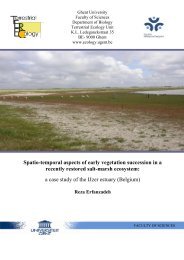PhD Arthur Decae 2010 - Ghent Ecology - Universiteit Gent
PhD Arthur Decae 2010 - Ghent Ecology - Universiteit Gent
PhD Arthur Decae 2010 - Ghent Ecology - Universiteit Gent
You also want an ePaper? Increase the reach of your titles
YUMPU automatically turns print PDFs into web optimized ePapers that Google loves.
Abbreviations. Most terms and abbreviations used are standard in arachnological literature<br />
and/or are previously explained in <strong>Decae</strong> 2005 and <strong>Decae</strong> & Cardoso 2005. For convenience<br />
the following abbreviations are here given: BL = total body length measured from the apex of<br />
the chelicerae to the most caudal tip of the abdomen; CL = length carapace, CW = width<br />
carapace; SL = length sternum; SW = width sternum; LP = length palp; LL1 = length leg I;<br />
LL2 = length leg II; LL3 = length leg III; LL4 = length leg IV; AR = length anterior eye row;<br />
PR = length posterior eye row; EL = length eye-formation; Clyp = clypeus length measured in<br />
a straight line from the anterior edge of the left ALE (anterior lateral eye) to the anterior edge<br />
of the carapace; POP = deep black periocular pigmentation; MTF4 ratio = relative lengths of<br />
metatarsus, tibia and femur of leg IV; PMS = posterior median spinnerets; PLS = posterior<br />
lateral spinnerets. MNHN = Museum National d’ Histoire Naturelle, Paris; NMR =<br />
Natuurhistorisch Museum Rotterdam; ZMUC = Zoological Museum University Copenhagen.<br />
Qualitative characters. Traditional descriptions of Nemesia species have focused on colour<br />
and spine patterns, and descriptions of the eye formation. Such information is of descriptive<br />
value but is rarely sufficient for species diagnosis. Descriptions of the male palpal organ<br />
found in the literature are of diagnostic value although older information and figures are<br />
generally too superficial to make conclusive determinations possible. Here, we give more<br />
detailed diagnostic information on the morphology of the sexual organs of both males and<br />
females and descriptions of the following qualitative characters that were found to be of<br />
diagnostic value: Crest zone, the colour pattern of the integument and the settings of setae on<br />
the crest of the caput were found to vary consistently between most species. Pubescence, the<br />
presence or absence and the colour of pubescent hair on the carapace, chelicerae and leg<br />
segments may be of important diagnostic value in Nemesiidae at the species level. POP, the<br />
pattern of the deep black pigmentation between and around the eyes has diagnostic value.<br />
Fovea, the shape of the fovea and in particular the presence or absence of a short central<br />
groove that runs perpendicular to the main recurved transversal groove of the fovea contains<br />
diagnostic information. Fang ridge, the ventral prolateral ridge on the fangs may be smooth,<br />
neatly serrated or irregularly broken (see <strong>Decae</strong> 2005 Figs. 2.6−2.8) in different species (and<br />
sometimes in different sexes of one species). Furrow teeth, the number of teeth and the<br />
position of the largest tooth on the prolateral edge of the cheliceral furrow is rather constant<br />
within species, and variable between species. In our descriptions we number the furrow teeth<br />
from distal to proximal (e.g. ‘tooth 5 largest’, in a row of six teeth means that the tooth most<br />
proximal but one is the largest in the row). Cuspules, the number, pattern and shape of the<br />
maxillary cuspules may vary between species. Spinneret morphology, (Figs. 38, 40, 42, 44,<br />
46, 48) is an important diagnostic character in Nemesia species both to distinguish females<br />
and to relate conspecific males and females. PMS, are always reduced in Portuguese Nemesia<br />
and always absent in Iberesia (see <strong>Decae</strong> & Cardoso 2005 Figs. 1-9 & 1-10), the shape of the<br />
PMS and the pattern of spigots however, are of important diagnostic value at the species level<br />
in Nemesia. PLS, the relative length of the basal segment (seen in ventral view) and the<br />
pattern of spigots on this segment are of diagnostic value. Maculae, the presence of dark<br />
pigmented blotches (maculae) on the external leg segments and/or on the external basal<br />
segment of the PLS (Fig. 38) is a conspicuous character that has had much attention in<br />
literature and has led to much confusion in Nemesia taxonomy. The presence or absence of<br />
maculae is of diagnostic value when used in combination with other characters. MTF4 ratio,<br />
the relative lengths of metatarsus, tibia and femur of leg IV are of diagnostic value and given<br />
here e.g. as Me4>Ti4; Ti4=Fe4 (metatarsus IV is longer than tibia IV, and tibia IV is as long<br />
as femur IV).










